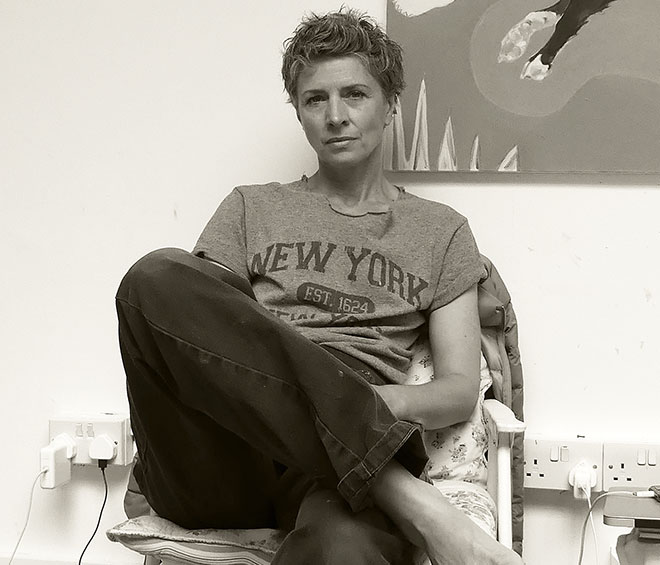
Clae Eastgate. Photo © Clae Eastgate.
by ANNA McNAY
Clae Eastgate (b1968, Nottinghamshire, UK) is a largely self-taught portrait painter. For 16 years, she worked primarily as a commission artist, but her current project, Painting the Poets, sees her building a collection of portraits of female poets – a “legacy project”, she says, at “an unprecedented time in history, in terms of the growing cohort of female poets”.
For Eastgate, painting a portrait is not just about achieving a physical likeness. For a portrait to be successful, it requires a balance of several elements – a sometimes elusive proposition – allowing the telling of a story through the visual representation of what is being communicated emotionally, or through the use of allegorical self-symbolism. Accordingly, each painting she makes will have its own style, echoing something of the sitter, as well as Eastgate’s own development as an artist.
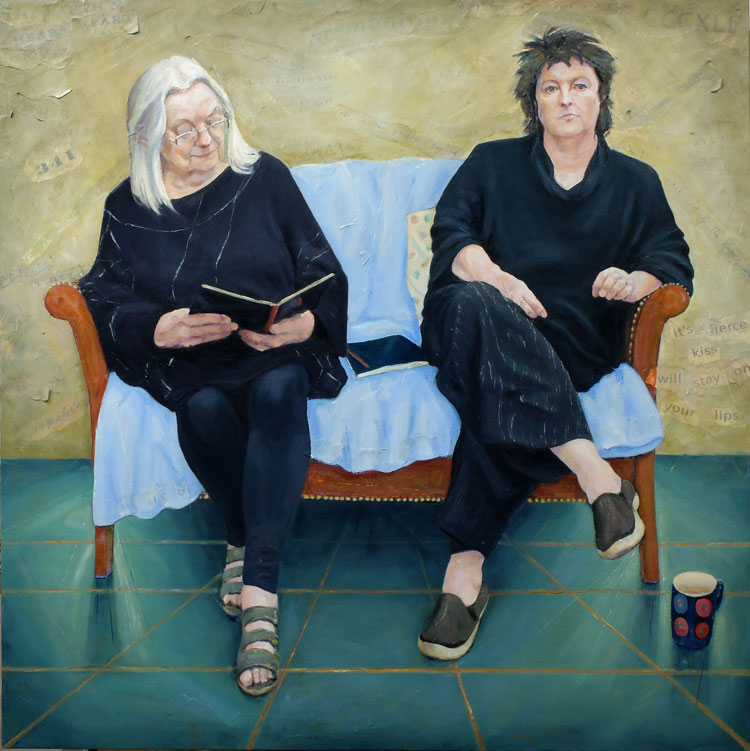
Clae Eastgate. The Poets – a portrait of Gillian Clarke and Carol Ann Duffy, 2017. Oil on canvas, 48 x 48 in. © the artist.
A perfectionist to the core, Eastgate, through this project, is learning a lot about the challenges and rewards of the art world, and hopes to present the portraits, not just as works in themselves, but accompanied by poetry recitals, and perhaps even live painting events, creating a much wider platform for women to express themselves artistically – and be heard.
Studio International spoke to Eastgate at her home in Shropshire.
Anna McNay: When and how did the idea for you to create this series of portraits of women poets come about?
Clae Eastgate: It was late 2017, early 2018, and I had just completed a double portrait of Carol Ann Duffy and Gillian Clarke, and it was on show at the National Portrait Gallery in the BP Portrait Award. It really came off the back of that and getting to know them a little bit. I began talking to one or two other poets, and I woke up at three o’clock one morning, thinking: “Why don’t I continue painting poets?” I love poetry. I’m very drawn to writers. It’s like the other side of me, which I didn’t become but always wanted to be. I ended up being a painter instead. I still wonder whether that was the right choice, but, hey. I love being in the company of writers, it’s where my heart is. Poetry, for me, is something in between the written page and a painting. It’s so accessible, immediate, impactful and evocative, and it somehow plays into my work. As a kid, I used to write what I thought were lots of songs, but, actually, they were probably just little poems. There’s a part of me that’s the poet that never was. A lot of my family are musicians, and so it felt, not like a homecoming, that’s a bit too cliched, but it was as if it were always meant to be.
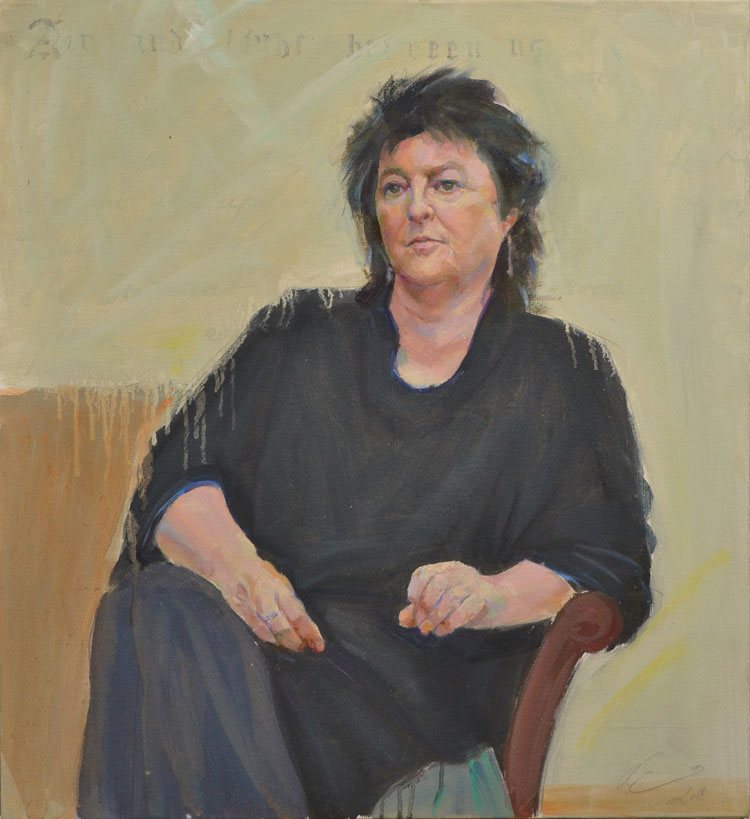
Clae Eastgate. Air and Light – a portrait of Carol Ann Duffy, 2018. Oil on canvas, 18 x 22 in. © the artist. Scottish National Portrait Gallery permanent collection.
I’m very much into women’s issues and the progression of women in creativity and art, and I wanted to see it from that perspective, from the perspective of the female gaze. So, I started looking at female poets. There have been the most wonderful poets in history, but mostly as isolated figures. More recently, over the past decade, whether it’s due to Carol Ann Duffy taking the first British laureateship as a woman [in 2009] or other factors, I don’t know, but there is a growing cohort of women making their voices heard. I spoke to one or two younger female poets who are on the scene, and they gave me all these names. That’s how it started. They got excited, I got excited, and suddenly I had 20 women on my list to go and see. I’ve had sittings with most of them now, and the main paintings are in progress.
AMc: You’ve described it as an unprecedented time in history, in terms of the growing cohort of female poets …
CE: Yes. I think women are tentatively taking those tiny little steps towards being more visible in the arts. We’re still, as you well know, a long way off from equality. It’s two steps forward, one step back. But there’s a strength in women feeling that they can express themselves. Factors such as social media platforms have also made it that much more accessible for people – women – to do that too, worldwide. There’s a connectivity that didn’t exist before.
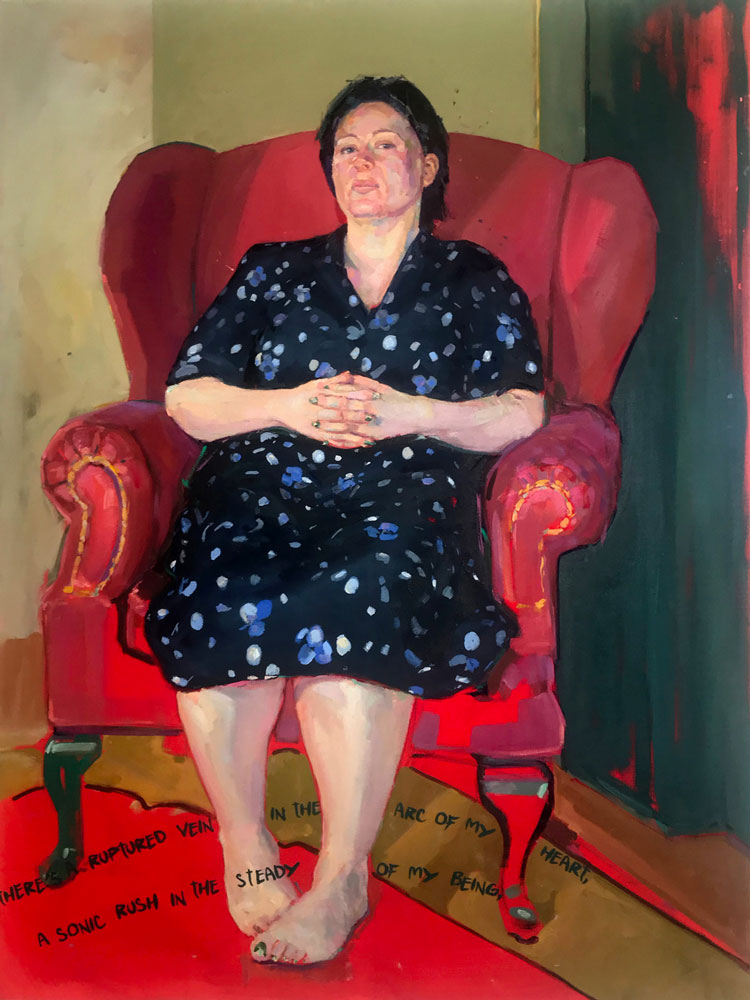
Clae Eastgate. Melissa Lee-Houghton, 2020. Oil on canvas, 30 x 40 in. © the artist.
AMc: Is your list of poets to paint now finite, or is the project still developing?
CE: It started off as a finite list. I got up to about 25 and thought: “This has got to stop.” But then, as the project has evolved over the past two years, I realised that I was putting the cart before the horse in terms of my aspirations for an exhibition and a tour. Initially, I wanted to get 20 paintings together and then show them all together for a great big launch. I had a team of people working with me, and money was pouring out of my bank account. Things were a bit out of control. I realised I hadn’t got the work ready, and so I couldn’t really go and look for venues or pitch to big art institutions. I had the idea, but I simply didn’t have the work to show for it. So, I slowed things down, and it’s been a massive lesson for me in so many ways. From starting out thinking: “Oh, this is great, I’m just going to explode into the world and on to the art scene with this fabulous idea!”, I’ve gone really quiet and reclusive. I just want to be little me and stay quiet and the way I know. But also let the idea go out on its own and let someone else have a look at it. It’s become much more about the work that I’m doing, connecting with those women individually, being changed and humbled by some of their life stories, which are extraordinary, and looking at my creative practice in a very different way.
I’ve taken a big step back from it and allowed it to evolve organically in the way that it wants to, and it’s slowly dawning on me now that it’s going to be more of a lifetime project than something I can complete in the one or two years I had given myself at the beginning. I mean, one big painting is taking me six months, so I don’t know what I was thinking before! It is moving a lot more quickly now that I’m getting into the flow of it, though, but my technique is at a crossroads anyway. I’m doing lots of exploring with my work. I’m just allowing it to be, and it’s got its own momentum, it’s like its own beast. I’m just the artist feeding information into it and doing the work. I don’t feel it’s out of control, I just feel very differently about how I sit with it. I’m really enjoying it now that I’ve taken the pressure off. I have a creative director whom I work with on the project, too, and the more we discussed it, the more I realised that the pressure was becoming so great that I couldn’t function properly. It was swallowing me up, and I was getting really down. I started to feel quite negative about it, and, for me, that is the most depressing place to be because, without work, without painting, I feel I have nothing, and I don’t feel it’s worth being here. I know that’s a bit dramatic to say, but it’s true. I needed to be in a more positive place with it, a place where I could cope with it properly, and where it was enjoyable, because, if I don’t enjoy it, then I’m definitely in the wrong job.
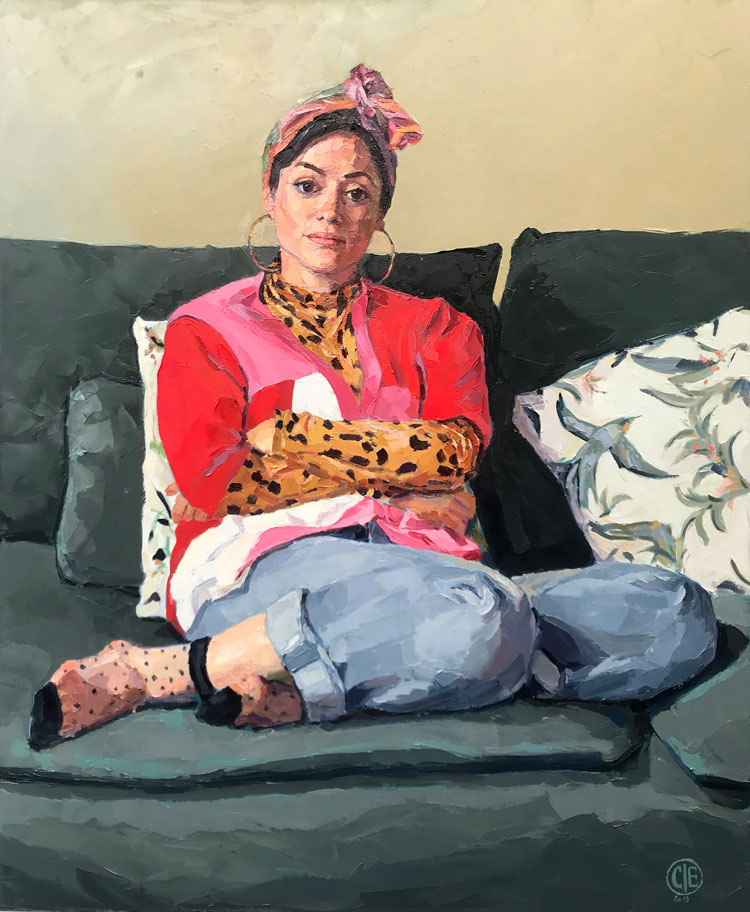
Clae Eastgate. Sabrina Mahfouz – a portrait, 2019. Oil on canvas, 26 x 34 in. © the artist.
AMc: And if you’re not enjoying it, it will be visible in the work as well …
CE: Exactly. So now I’ve relaxed a bit, and I am enjoying it. It’s hard. It’s a really, really difficult subject matter. I mean, portraiture is massively difficult anyhow. Ask any portrait artist. It’s really, really hard. But, yes, I just want to enjoy it, and let it take as long as it needs to take.
AMc: Do you work on one painting at a time, or have you got several on the go at once?
CE: Several. I’ve just started the Kate Tempest painting again, which I had done already, but I looked at it in my studio in London the other day and thought: “No, I’ve got to do it again!” I’m a terrible perfectionist. I’ve probably got about five paintings on the go at the same time. For me, that’s a healthy way of working, because there’s nothing worse, and you’ll know this from your work, than when you look at a piece of work and think it’s probably OK, but you don’t know for sure because you can’t get away from it. You can’t see it. You can’t understand the words or what the picture is saying, whether the colours are working. You just have to turn it over against the wall, or turn it upside down and go and work on something else, go and do something else, and then, one day, you’ll walk into the studio and see what it is that needs changing. It’s suddenly clear. That’s why I work on five or six paintings at the same time. One day I’ll do something on one, and another day I’ll do another piece. It’s a bit overwhelming.
AMc: Would you say there is a consistent style to them all, or are you led by the poet and her personality?
CE: A bit of both. I think, predominantly, my style and my work are evolving and changing so quickly because I’m doing so much. I look back at the first painting, which is of Victoria Adukwei Bulley, and there was all the gold and the shine in the background, and then I look at the painting I’m doing today, and the brushes I’m using, and how thick the paint is … It’s not that it’s a different artist, and I’m very wary of being too disparate in my style – other people will see a continuation – but it’s that balance of, as a viewer, seeing an artist evolve and progress, which I think is really important. If you stay the same, with the same style and the same technique, for me that’s quite stagnant. It’s wonderful to see artists’ careers progress – whatever discipline they are – and to see how they look at things differently from when they were in their 20s to when they are in their 60s. That’s the beauty of it. It’s the life that people get excited about, it’s what they want to read about, it’s what they want to look at.
So, yes, the paintings are quite different, but, also, to answer the other side of your question, they are very different lives. There are one or two who had other careers and did their poetry on the side, only recently becoming full-time poets; there are others who have only ever done poetry from a very early age; and then there are others who have been in all sorts of situations and gone through so much trauma that poetry has come out of it. This is often the case, and those stories of trauma are a very private exchange between painter and sitter. They’re telling me what happened to them when they were a little girl, while I’m painting them, and I’m falling apart at the easel, but it’s all coming out, and I’m hugely respectful of that trust. A lot of the words they write, and how they project themselves into the world, are about those times, but also not about those times. It can be metaphorical, it can be so many different things. We are all our work, even if we’re writing something very academic. Between the lines, you can see that person. It’s like that in my paintings, too. I try not to just do a traditional portrait, I have to build a story around it, whether that’s literally using text from their poems, or some allegorical self-symbolism. I need to try and compose that, and it takes a long time to get those ideas together. And they can change halfway through, and then I have to rip it all up and start again. That’s happened so many times, which is why it’s so difficult. I have to be true to the poet, but also remain confidential, so it’s about balancing that respect of not saying too much, but also not saying too little.
Usually, they love the idea of being painted, and they want to shine through it, but they are also nervous about it, and a little bit tentative. I mean, who wouldn’t be? How is this person, whom I don’t really know that well, going to depict me? How are they going to present me to the world, in their world, with all those other people, in a different form of an art world, all looking? How many people are going to see it? Who’s going to see it? What are they going to think? And so on and so forth – the questions are endless. The most difficult part of my work is composing and putting a piece of work together. It’s not just about painting a portrait, it’s about so much more. But that’s what I love about it. I want my portraiture to be that bridge, that in-between being, between a genre painting and a traditional portrait of someone’s face.
AMc: Do you try to read the works of each poet you are painting?
CE: I try to read as much as I can. I dip in and out. A lot of them write novels or essays as well. They write all sorts of stuff. I ask them if I can have snapshots of their notebooks, because there are usually doodles all over them, which are very telling of their character. I know mine are, but no one’s going to see those! It’s really important to get a flavour of their work and what makes them tick. Then, obviously, the sittings are super important to really meet them and spend time with them. It’s not about getting a figuratively representational portrait of them as a reference, it’s more about talking to them and getting to know them, while I’m daubing away at my little oil sketches. What’s happening at the easel is almost incidental. It’s more about the interaction. It provides a way for us both to relax, because I’m doing something, so I’m not concentrating so completely on them. They talk, I fill in the gaps, and it’s great. Everyone opens up. They just start talking. They can’t stop themselves.
AMc: It is a bit like being on an analyst’s couch.
CE: Well, it’s really interesting because some of my clients have never had their portrait painted before, and it might have been commissioned by a partner or someone else, and I speak to them afterwards, and they say: “You know, Clae, that was just the best therapy session I’ve had in ages!” Usually, I tell them something a bit intimate about my life, or am just open, for example: “Oh gosh, when I was a kid, I did this, and now I look back on it, blah, blah, blah …”, and then, suddenly, that opens up this whole area of, well, intimacy, I suppose, for want of a better word. It’s always very private, no other people around, no distractions. It’s about providing a safe space for someone, always. There’s no point doing it otherwise. For me, that’s really key. I do use photographs, but I find it really weird when an artist just works from photos, and they’ve not met the sitter. How does that work? We all do different things differently, I guess.
AMc: Presumably, though, you are not able to have them sit for you for the whole portrait?
CE: No, it’s just too inconvenient for the way we are nowadays. If I could have that time, like Lucian Freud with his 800 sittings … But that was torture for everyone. I’d love to have a few more sittings, but these particular poets, some are very well known, and they’re out there touring and writing, and they don’t want to be disturbed. I have to respect that, so I explain to them in my initial introduction email, tell them what I’m doing, and say that if they can give me just one sitting, for an afternoon, I’d really appreciate it. I always go to them, and, like I say, I use that time really just to talk to them and get to know them, and I do lots of little oil sketches, just of head and shoulders. I’ve got a big drawerful, and I want to do that as a show in itself, just pinned on the wall, not mounted and not stretched. They’re a real story in themselves, those little bits of canvas. They’re like the session sketches, and, to me, they’re like colour charts, so I’ve got truer colour to work from. But, also, there’s somehow an essence of the sitter’s character that comes into them, even if I’m talking to them and not really looking at what I’m doing. They’re reference points. But I take lots of photographs as well. That’s all about building the composition and painting itself: where they’re sitting, the stuff in their studios or writing rooms that they collect and look at, their environment. I take lots of pictures while they’re talking. I have all these images, and all their books, and I pile it all around me and throw myself into their lives and see what comes out the other side. It’s quite intense.
AMc: Tell me about the process of making the actual work. Do you draw it out on the canvas first?
CE: Yes. Usually the composition comes to me at about 3am.
AMc: Everything seems to be at 3am!
CE: It’s that hour, isn’t it, the creative hour? And while it’s torture, because I lose sleep, it’s also the most magnificent time, too, because your brain is firing on all four cylinders. I don’t know whether you get this?
AMc: Not at 3am!
CE: Right, well, my brain just fires up between 3am and 4am. Not every night, but those are when the ideas come, and I suddenly see it. It’s like a vision, and I’m aware that my fingers are drumming on the mattress because I’ve got it, and it all fits together. I eventually get back to sleep, and I let it go, and then, if it comes back to me one or two days later, which it often does, I tweak it, and I get a sketchbook, and I write out or draw out an idea. Then I start looking at all the photographs, and how I can pull different elements together, and I start to build the basic composition in Photoshop. When I come to actually paint, I print out what I want to do, draw on top of it, and use photographic elements, too. It’s like a montage, basically. Then I transfer it up on to a larger canvas and work from there. It doesn’t always work. What works on a small screen, or in a small sketch, can often not work on a larger scale, and vice versa. It’s a bit hit and miss, but that’s how it usually happens.
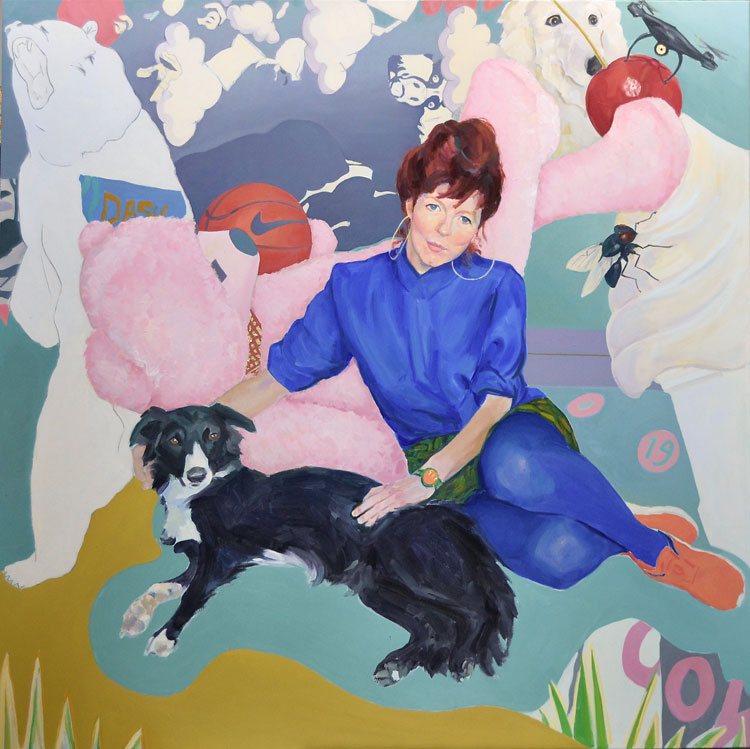
Clae Eastgate. Heather Phillipson – a portrait, 2018. Oil on canvas, 48 x 48 in. © the artist.
AMc: How are you defining “poet” for the scope of the project? For example, you have already mentioned Kate Tempest, and I see you have a portrait of Heather Phillipson in the series, too. Is she a poet as well as a visual artist?
CE: Oh, Heather is fabulous. Have you seen much of her work?
AMc: I’ve seen her Art on the Underground installation at Gloucester Road.
CE: She’s doing the Fourth Plinth in Trafalgar Square, too. It was supposed to be this year, but I don’t know when they’re going to haul it up there now. Heather was one of the first poets I went to see, in her studio in Hackney, east London. She’s multidisciplinary. She makes installations and films – she won the Derek Jarman award – but she’s also a multi-award-winning poet. She’s really flying in her career, but she doesn’t like any publicity. She is very private. She doesn’t give a stuff about becoming well known as an artist, which I just love. If only we could all be like that. I think she’s a very clever artist. She’s very humorous, but also deadly serious, very deadpan at the same time. I love her work. It’s so weird and wonderful, different and refreshing, and I can’t wait for her bloody great big ice-cream cone to be up on the Fourth Plinth. It’s going to be fantastic.
But I’m guessing your question was going to be more about their different styles and how to present that?
AMc: I was just wondering how you were defining poetry, really, because it’s not just in the strictest sense of something written on a page in verse …
CE: Right. I wanted it to be as diverse as possible because it just is these days. It’s no longer an audience of stuffy, 70-plus elitists, seeking high art, opening a book of Wordsworth, and getting off on that. Now, we have Kate Tempest, who has bridged that gap to a much bigger and younger audience, to rap artists, and to artists and poets long prior to her. The idea of the spoken word dates to Ancient Greece, and it’s all coming back. We had spoken word before the pen or the pencil were invented. That’s how we communicated. So, I definitely wanted spoken-word artists in the mix. You have to be very careful about what you call them, though, and I always have to ask: “Are you a spoken-word artist, a performer, an off-the-page poet, or are you this, or are you that?” They’re very specific about who they are as a poet and how they define. Now, I think it’s much more accepted that there are different forms of poetry, just as there are different forms of painting and different forms of music. There’s room for everyone, and I wanted to have a diverse selection of poets to capture this. Carol Ann Duffy uses music and props in her poetry readings. It’s fabulous, very funny, and until I started going to readings, I really had no idea what to expect. The cliche is, “Oh, it’s going to be boring,” but, actually, it’s anything but. It’s electrifying. Maybe some of the older poets tend to be more written word and, when they read, they are reading off the page at a podium. But then you get the other extreme – Kate Tempest or Hollie McNish, for example. Hollie’s an Insta-poet. She’s got thousands of followers on Instagram and does her thing through that. She also tours, but when she reads, she’s also more off the page, more traditional in that way. She’s not a performance poet at all. Then you’ve got people like Joelle Taylor, who’s a loose cannon, but very much a performance poet. She punches the sky, she’s fantastic. I wanted them all to be different, to give that diversity of what poetry is, and how what these women are saying to the world is so important.
AMc: Am I right that you have also made some short films of the poets as they were being painted, in conversation with you?
CE: I’ve done a couple, and I’m going to do a few more. I’m going to go on a course to learn how to use my iPhone to film on properly, since that’s the done thing these days. I did have some films made, which were great, but costly, so I need to find another way. I’ve asked the poets in the past whether I could do it at the time of the sitting, but it’s never quite worked, because the intimacy is not there. You can’t film something and meet someone properly for the first time. Bethany Rose, the spoken-word poet, is going to come and perform some poetry and help me with the painting, and we’re going to film it all, and hopefully we’re going to get a gallery to exhibit it while we’re doing it, as a piece of work in itself. That’s actually something that was on the cards for this year. Like Heather, Bethany also does lots of illustration and drawing. I love the idea of working on a painting with one of the poets at the same time – and making that an artwork in itself. The project is always morphing and changing, growing little tentacles. I want it to be different, not just a series of portraits of poets. I want it to have its own art form, in a way.
AMc: You also intend to produce – or have produced – an anthology of the poets’ work.
CE: It’s something that’s on the cards, which I’m going to try and put together with the poets. At the end of the day, I’d love there to be a book – a collection – of the poems next to the paintings. But that’s way down the line. I’ll probably be in my 70s by then!
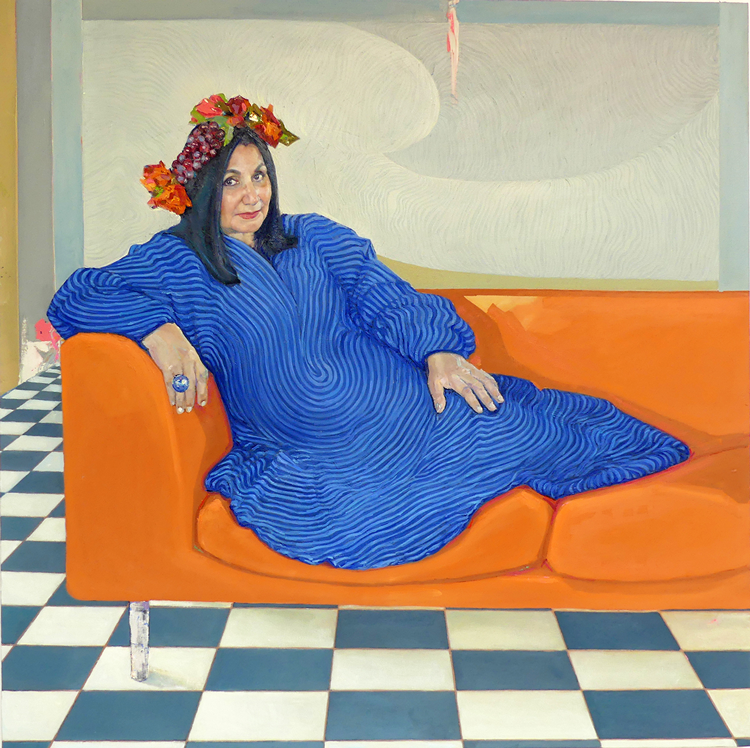
Clae Eastgate. Imtiaz Dharker, 2020. Oil on canvas, 48 x 48 in. © the artist.
AMc: What is next in terms of events, then? I know you said at the beginning that you had taken the pressure off yourself from trying to get all of the portraits finished so that they could be shown and toured together any time imminently …
CE: Well, at the end of this year, there is a big poetry library opening up at Manchester University, and Carol Ann is opening it along with Imtiaz Dharker, Jackie Kay and some of the other poets, and, after the opening day, as part of the opening week, some of the paintings are going to be shown there, and we’re going to have a night of poetry and paintings – like a private view, but with a bit extra. That may now be pushed into next year, though. I’ll mainly be showing portraits of more northern poets there: Kay, Duffy, Helen Mort, Kim Moore, Melissa Lee Horton ... I hope there will be something in London, too, but I don’t want it just to be London-centric. There’s going to be something in Scotland, too, at different venues, not necessarily galleries. I like the idea of having exhibitions in libraries. I’m talking to the Glasgow Women’s Library, for example. I want it to be outside the box a little bit and not too precious. It doesn’t need to be in some sort of fancy gallery. But that would be nice, too … It would help me to sell as I go, as well, because I have to survive as an artist. I don’t have any other income, except from teaching and commissions. So, when they do show, I hope there will be people who will collect them and then allow them to go on show again as well. Money has to be important, unfortunately, but it’s very much more about the project itself, and what it means, and there is a serious side to it. I’d love to reach more oppressed cultures, to get other artists to create similar platforms where women can be heard. We constantly need to be heard, so as not to go under. It’s just this constant thing of trying to push, push, push, because if you don’t push, you just get shoved back down again. I want to create these platforms for women and girls. I want those words to be out there. I want this project to constantly bring attention to the need for that. That side of it is very close to my heart.
AMc: Tell me about a bit about your background. You grew up in Shropshire, where you live part of the time now, and you studied fine art at Birmingham School of Art before moving to London.
CE: I grew up mostly in Shropshire, yes, although I moved around with my parents quite a bit early on. I left home quite young and went to live in London after travelling in the United States. I went to art college in Birmingham, but I didn’t stay, because I absolutely hated it. There was no one to teach you how to paint. It was still very much in the 60s mentality of ideas and concepts. It’s still the same. I was very disappointed with it, so I gave my place away. I wanted to come to London, and I wanted to go to one of the more traditional schools, like the Slade, and learn how to paint well. When I moved, I did go to the Slade and do courses, and I did loads of life drawing, too. We just found empty buildings and had sessions in them. We all clubbed together as artists and found lots of strange, wonderful models and lit a fire. I lived in Spitalfields before it became anything like it is today. It was empty. I had one of the first studios, and Spitalfields Market was full of artists from all over the world. We all got thrown out. Those were my early days. I studied sculpture, but I’m basically self-taught as a painter. I moved out of London quite a while ago now, and it’s only over the past few years that I’ve just started going back and teaching there, simply because I need to make money, because it’s not enough just doing what I do here. And also because I became too isolated. As wonderful as it is here, I do need that city stimulation and buzz. I’m lucky because I have somebody who can facilitate that by giving me a place to stay. My idea is to try and get some sponsorship for the project, to give me more time to do it, so I also have time to do all those other things, like the teaching, that keep the bread on the table.
AMc: I’ve spoken to so many artists who teach alongside their practices, and who say they find it really draining of their energy …
CE: It’s massively draining. I love teaching, but it is draining. I can’t teach at the moment because of lockdown, and I haven’t done any virtual teaching because the time it would take to get my head around it and set everything up would be too much. Also, when I teach, it’s very one to one. I have classes with about eight people, but I work intensely one to one, going from one student to the next. I just couldn’t do that through a screen. This period of time, of isolation, has shown me just how tiring I was finding the teaching. I was placing way too much focus on it. I was becoming known as a teacher, rather than as a painter. I don’t want it to be that way round. I have to figure out whether I go back to more commission work, or, as I mentioned, I really hope to find a good, hopefully female, sponsor from the arts. An art collector or a philanthropist of some sort. She is out there, or he is out there, and I know that it’s just about getting the project out there now, into the public arena, to attract those people who will support it, because everybody loves the project. I’ve had some donations, and I do get a little bit of sponsorship, but it would be nice just to have that big chunk of time … Wouldn’t we all like to have someone say: “Here’s 50 grand, go and work for a year, buy all the materials you need, produce some great work, and don’t worry about anything.” Oh my god, it would be like a dream come true.
AMc: Have you stopped doing commissions altogether? You used also to paint portraits of dogs …
CE: I did. I’ve always been a little bit embarrassed about it, a bit sheepish, but that’s how I started. I have to respect it though, because it earned me a living. It was just by accident. I was travelling in Boston and I met somebody who owned a gallery, and it happened to do a lot of dog portraits, because they’re so big on that over there, and people pay a fortune for a portrait of their pooch. The gallerist took me on as a commission artist, and I made lots of money just churning them out as if there were some kind of mutt artist production line. It was like baking cakes, it was ridiculous. But that sowed the idea. When I came back to London, I thought: “OK, why can’t I do that here?” That’s how I managed not to have to go and get another job. It meant I could paint full-time, and it taught me to paint, too. I have to respect that those early days were very informative, and they gave me the direction to be where I am today.
In terms of commissions now: I’ve had several on my books for the past year and I’ve kept shoving them on to the pile that I don’t touch. I’m actually just getting stuck into them now. In between doing the poets, I’m jumping on those commissions. Whichever way I look at it, however I earn money, it is always time consuming. There’s no way round it. I just have to try and balance it the best I can. Goodness knows where it’s going to go from here. Because I’ve been a commission artist, I’ve not really shown that much, I’m not out there on the scene in that way. Doing a project like this is probably the first time I will start showing in galleries more collectively and more frequently. It’s a different ballgame for me.
AMc: It really does seem like a timely project, and the kind of project that people would, should, and will support. It does, however, also sound as if you’ve got your work cut out for you, as you say, for a good few years to come.
CE: Just a bit! No holidays for me, barely a social life. Unfortunately, I have turned into a workaholic. It’s not good for much else in my life, but there we go.
• Air and Light, a portrait of the former Poet Laureate, Carol Ann Duffy, was acquired for the permanent collection at the Scottish National Portrait Gallery, Edinburgh, in September 2019.
• For more information, see ceastgate.com.